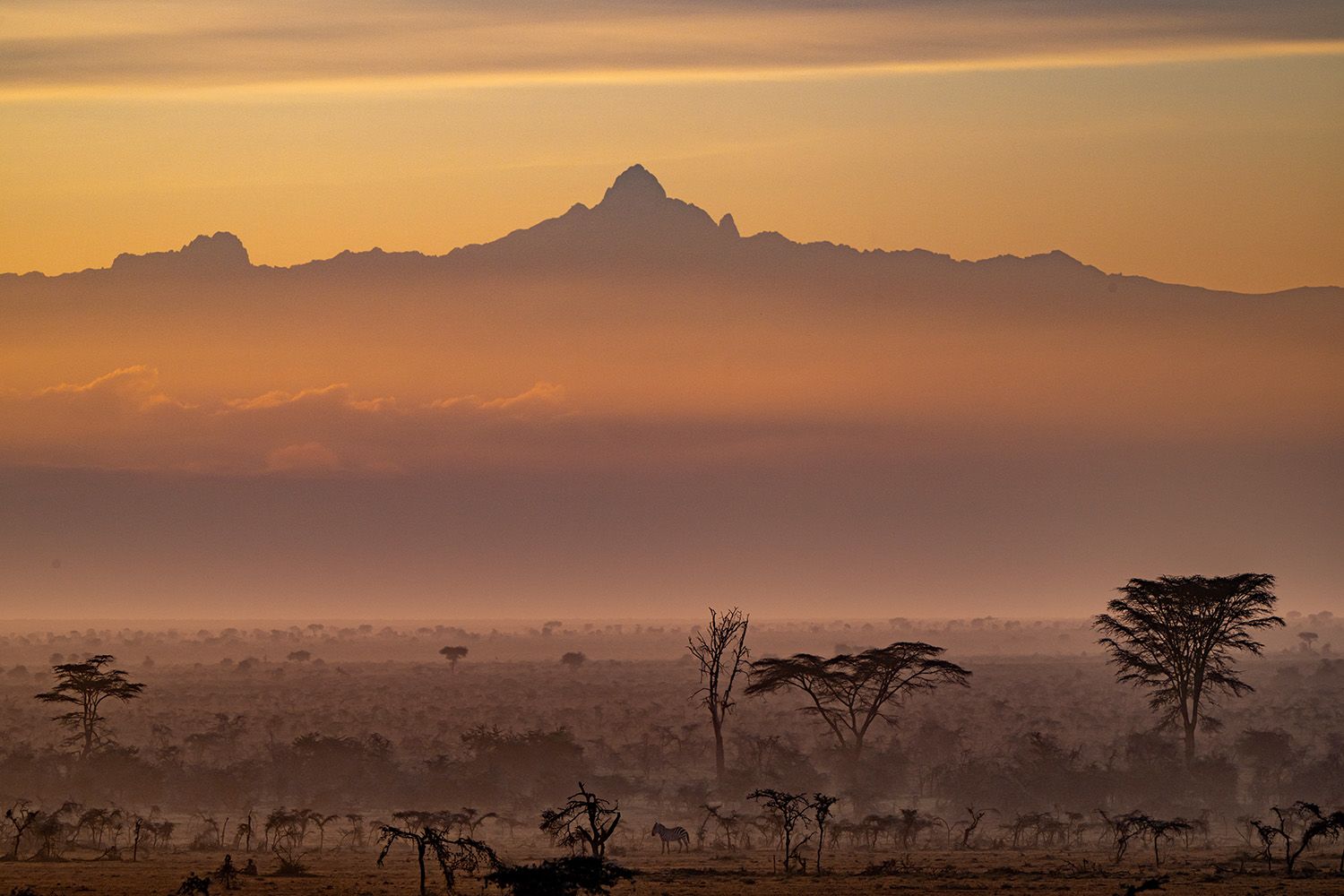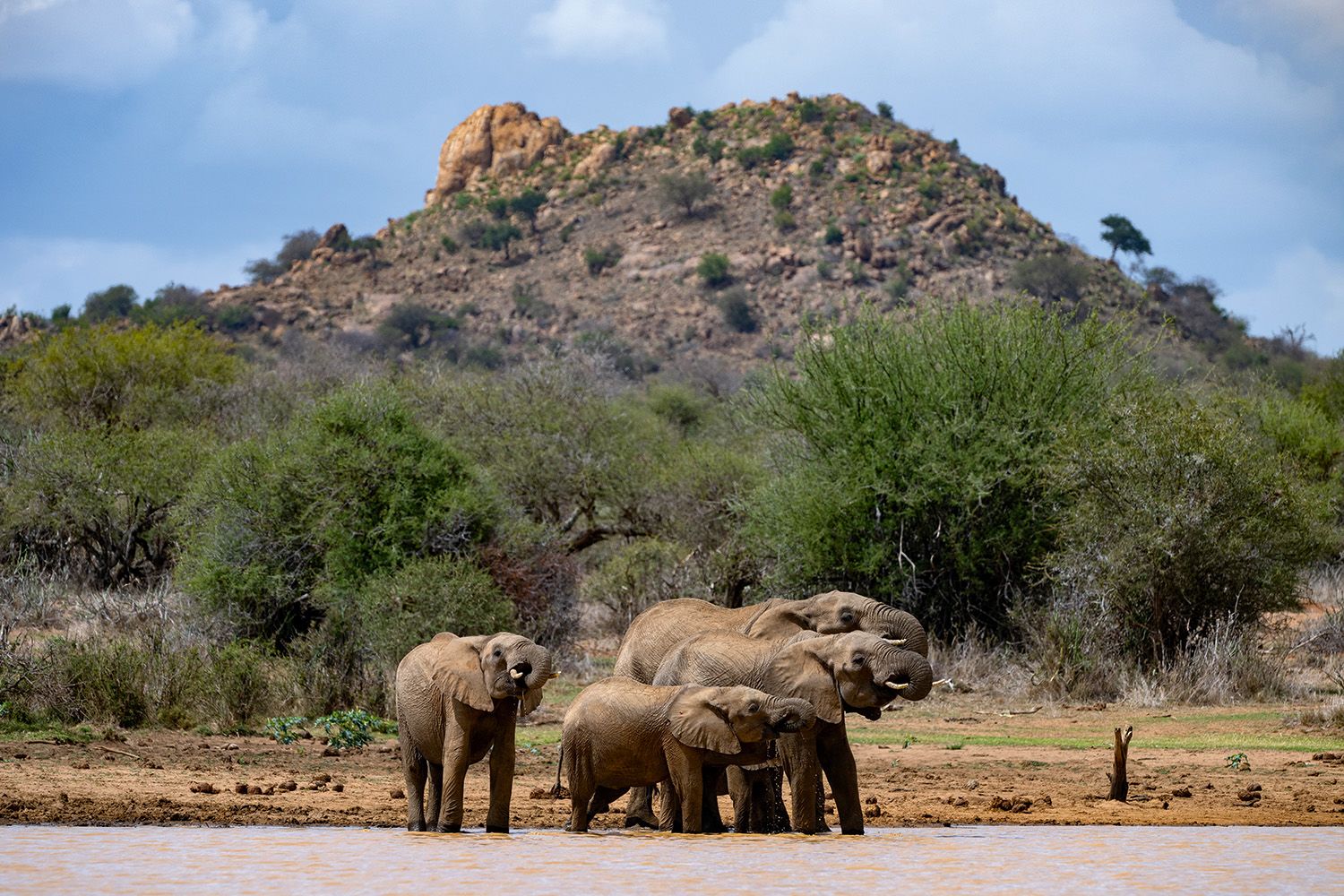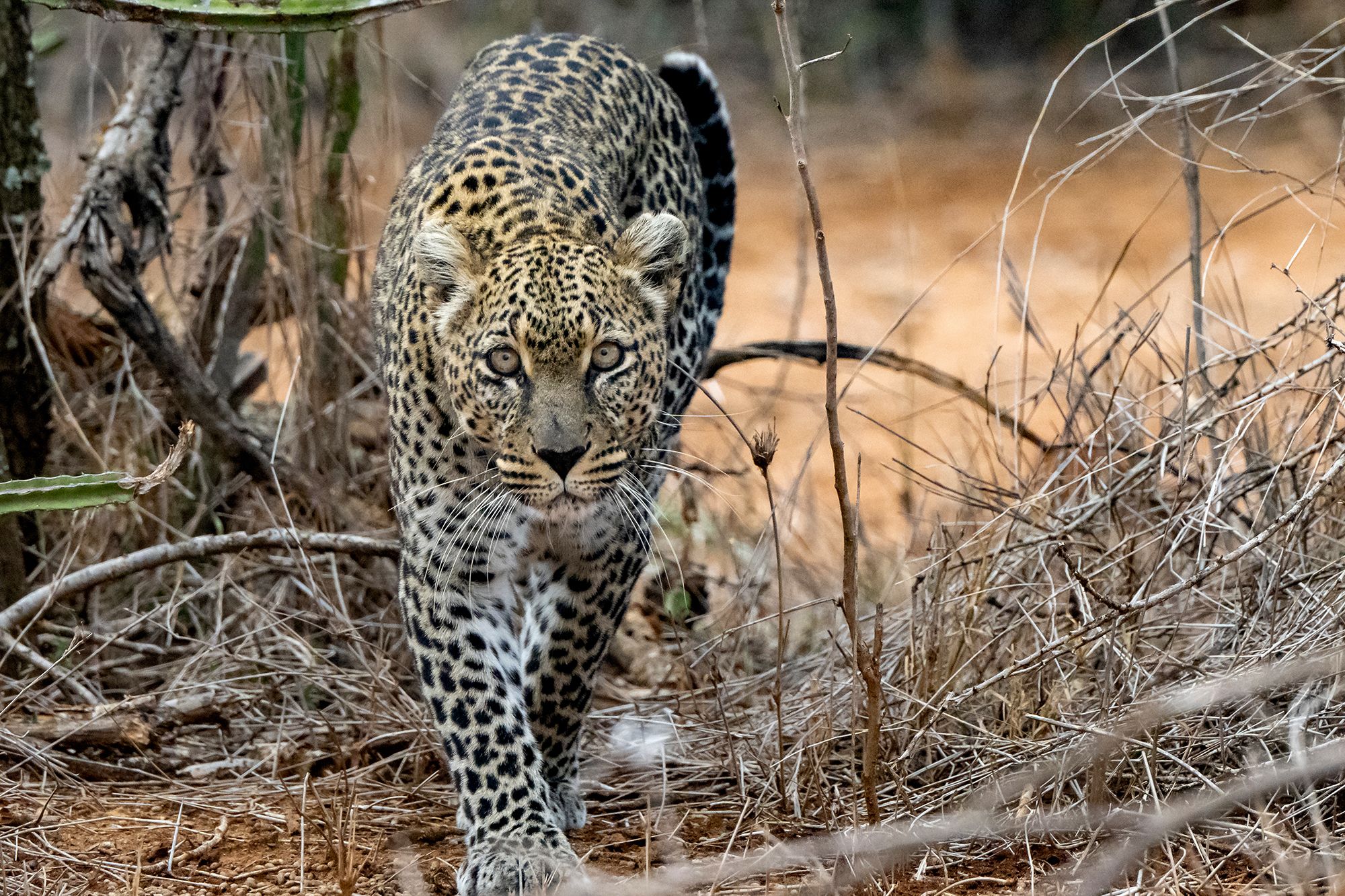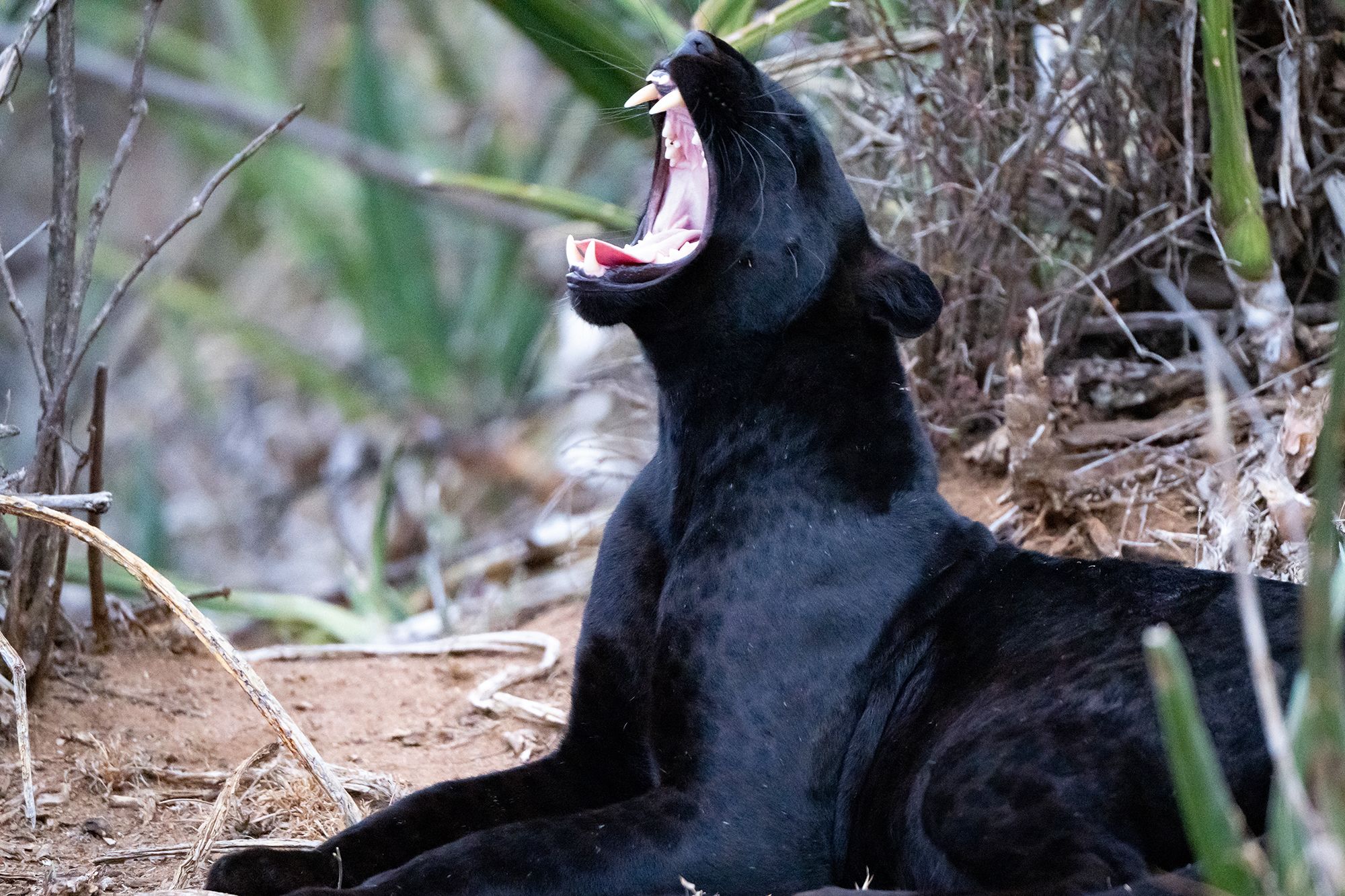A chance too good to miss
Seeking out Kenya's elusive black panther with Kate Humble

In the acacia woodland of Kenya’s Laikipia Wilderness Camp stirs some of the rarest wildlife in Africa – and the encounter of a lifetime.
Words Kate Humble Photographs Paul Joynson-Hicks
A rustle in the undergrowth gave them away. Beneath a tree beside my tent stood two tiny antelope – blue-grey with twig-thin legs, big cartoon eyes and the profiles of Roman emperors. They regarded me for a moment with a shrew-like twitch of their noses then skittered away. Dik-dik are so numerous here that there is barely a tree or shrubby bush that is without an attendant pair. But while they may be common, it is unshowy creatures such as these that ensure Kenya’s Laikipia Wilderness Camp is able to sustain far more unusual animals.
Dik-dik might be among the most common animal sightings at Laikipia but they are also a vital part of the ecosystem, and it is often the animals they attract that get visitors most excited
Dik-dik might be among the most common animal sightings at Laikipia but they are also a vital part of the ecosystem, and it is often the animals they attract that get visitors most excited
Laikipia lies at the foot of Mount Kenya, a two-hour drive from the town of Nanyuki. The wilderness camp sits on the scrub-covered slopes of a rocky outcrop, almost hidden. It was built by Steve Carey, who moved to this wild, sparsely populated area a decade ago and made it his permanent home. As a result, the camp feels very different from the luxurious safari lodges that proliferate Africa’s sub-Saharan wildlife hotspots. There are just six tents, each of them large, airy and comfortably furnished. The central mess is a cosy collection of chairs and sofas, and it is frequently shared with Steve’s four much-loved dogs. There’s a wood burner for chilly evenings, a broad covered deck and a large table around which everyone eats together. The food, prepared in the little kitchen behind the mess, is proper home-cooking and as tasty and unpretentious as you’d expect.
The true luxury here is not being cocooned in a carefully curated creation of African-inspired opulence, with the guarantee of seeing the Big Five in between gin and tonics and gourmet meals, but exclusivity of a different kind. The small size of the camp limits not only the number of people that can stay there at any one time, but also the number of vehicles. There is never a moment when you will find yourself parked up alongside ten other Land Cruisers all jostling to get the best view. And as the land is privately owned, there are none of the access restrictions of the national parks. At Laikipia you can go looking for wildlife at night or before dawn. You can go out on foot. You can even sleep out under the stars.
This set-up also offers more freedom to travellers, who can even camp out beneath the stars
This set-up also offers more freedom to travellers, who can even camp out beneath the stars
The landscape is not open savannah but acacia woodland spread across an undulating expanse of red-gold earth, giant boulders, hidden valleys and a sweep of river. It is harder to see animals here. It takes fieldcraft and patience, something the camp’s excellent Samburu and Kikuyu guides have in abundance, and this is the thing I love about coming here. It is, of course, always exciting just to happen upon a herd of elephant or a rarely seen bird like the glorious golden-breasted starling, but to find an animal thanks to careful detective work is a thrill that I never tire of.
“There is never a moment when you will find yourself parked up alongside ten other Land Cruisers”

This area of Northern Kenya is home to several regional specialities, including the dinosaur-like vulturine guineafowl as well as Grévy’s zebra, with its teddy-bear ears and hallucinatory stripes, and the beautifully geometric reticulated giraffe – the latter two of which are endangered. I first came here six years ago with the hope of finding African wild dogs, one of the rarest predators on Earth. Although not exclusive to this part of Kenya, there were three packs here that Steve was monitoring for the Laikipia Wild Dog Project. He was as familiar with their territory, habits and routine as if he had been a member of the pack, and that allowed me to get not just glimpses of these beautiful creatures, but to spend hours watching them socialising, hunting, playing, sometimes within metres of where we were sitting.
The African Wild dog population was decimated by disease in 2017, but it is slowly bouncing back
The African Wild dog population was decimated by disease in 2017, but it is slowly bouncing back
It was the dik-dik who were in no small way responsible for this thriving population, keeping those voracious packs well fed all year round. But disaster struck in 2017. Canine distemper swept through the packs, killing all but three of the dogs. Steve has continued to monitor them, and five years on, numbers are gradually recovering: there are now 16 mature adults. On my return, the dominant female had a den with an unknown number of cubs. They are harder to find these days, Steve told me, but we set out pre-dawn in the hope of an encounter.
The den site is inaccessible, hidden high among the boulders, but the pack sets out to hunt every morning. A wild dog hunt is a swift, coordinated attack. Their astonishing speed and agility, even in thick cover, makes them ruthlessly efficient hunters and – if you are lucky enough to witness it – unbelievably exciting to watch. And we were lucky, catching the tail end of the hunt, the final scraps of dik-dik being divvied up before the pack regrouped, panting and satiated, to lie in the early-morning sun, close enough for us to be able to watch them without binoculars.
A sighting of a rare golden-breasted starling
A sighting of a rare golden-breasted starling
Kate and photographer Paul Joynson-Hicks strike a pose
Kate and photographer Paul Joynson-Hicks strike a pose
The protected area of Laikipia spans nearly 405,000 hectares;
The protected area of Laikipia spans nearly 405,000 hectares;
A Grévy’s zebra perks up its teddy bear-like ears
A Grévy’s zebra perks up its teddy bear-like ears
Kate Humble searches for wildlife
Kate Humble searches for wildlife
Dik-dik are also the favoured prey of another of Laikipia’s predators. Steve believes that when the wild dog population crashed, the number of dik-dik rose and it was the leopards that were able to take full advantage.
“I’ve never known there to be so many in this area,” he told me. And sure enough, on my very first evening, I caught sight of a female striding nonchalantly alongside the track to the camp. Throughout the night, along with the whoops of hyenas, I also heard the grunting calls of leopards. The following morning we even spotted a leopard in broad daylight walking through the bush, unperturbed by our presence and giving me the best and longest encounter I have ever had with these most beautiful of big cats.
After all this, I was still hoping for something even more extraordinary. And if I’ve learnt anything in my 50-odd years, it is that you can never predict what life is going to throw at you. So, when there’s a chance – however slim – of doing or seeing something that really is a once-in-a-lifetime opportunity, I now do everything possible to try and make it work. And this trip offered exactly that.
Tanzania-based wildlife photographer Paul Joynson-Hicks had been tipped-off that an animal had been spotted here in Laikipia that, in all of his 30 years of working with wildlife in Africa, he had never seen: the black panther. I was eager to join his search for this elusive animal.
“We spotted a leopard in broad daylight walking through the bush, unperturbed by our presence”

To complicate matters, black panthers don’t strictly exist. They are not a separate species but rather a name given to a cat – usually a leopard in India or Africa, or a jaguar in South America – that, thanks to a genetic quirk, is entirely black rather than spotted. In India, these melanistic leopards, although unusual, are regularly seen and have been often photographed. In Africa, they still have almost mythical status, the evidence of their existence mainly anecdotal. Until now.
She emerged out of the dark on the opposite side of the river, walked over the rocks, paused to drink, then continued straight towards us, golden eyes blazing. If she had been a unicorn I couldn’t have been more stunned. The guides have named her Giza, Swahili for ‘darkness’, and in the spotlight her blackness was infinite, as if she had absorbed all the surrounding light. But as she came closer – and she came really close – we could see her coat was watermarked with a shimmering pattern of rosettes. She was breathtaking.
Black panthers are variations on a theme rather than a unique species, with their colouring caused by genetic quirks found within leopards and jaguars. If you look closely at Giza’s fur, you can still make out her leopard markings, and it is by no means guaranteed that her offspring will look like her – it will all depend on her future mate
Black panthers are variations on a theme rather than a unique species, with their colouring caused by genetic quirks found within leopards and jaguars. If you look closely at Giza’s fur, you can still make out her leopard markings, and it is by no means guaranteed that her offspring will look like her – it will all depend on her future mate
The following morning we found her again, just as the light was seeping back into the sky. In daylight she appeared even darker, like a silhouette, and somehow even more unreal. She allowed us to follow her for the next three days; we watched her hunt, climb trees and stalk the boundaries of her territory. Then she disappeared. We searched all her usual haunts – her favourite trees and rocks. Nothing. Then we heard a radio message. A black leopard had been glimpsed moving through a gully, but way outside Giza’s patch. We raced through the bush, eyes frantically scanning for her distinct black shape, her long tail gently kinked at the end. Nothing. We stopped, turned the engine off and listened for the dik-dik alarm calls that might betray her presence. Silence.
"She emerged out of the dark on the opposite side of the river... If she had been a unicorn I couldn’t have been more stunned."

“She’s there!” Paul whispered urgently, pointing over to the other side of the deep gully, and we caught a fleeting glimpse as she passed through a gap in the vegetation. Stephen, our guide, drove like the wind. We plunged off the road and into deep bush, ducking branches and dodging thorns, somehow navigating our way to roughly where we had seen her, eyes straining to see anything through the tangle of branches. Then there was a movement. A leopard slunk into view, but it was spotted and much bigger than Giza.
Giza gets the lay of the land from up in a tree
Giza gets the lay of the land from up in a tree
“It’s a male,” Stephen whispered. “Maybe she’s following him.” We held our collective breath, then we saw her.
Giza was born two years ago. She is on the brink of sexual maturity and is looking to mate. If the male she has chosen has the same genetic quirk as her, Laikipia may be home to black leopards for generations to come.
Need to know
The trip: The author travelled with support from Wild Frontiers, which offers itineraries that include Laikipia Wilderness Camp. Kenya-based tour operator African Experts handled all in-country logistics.
Visas: Required by UK nationals prior to travel; these are available online. At the time of writing, proof of Covid-19 vaccination or a negative PCR test was also needed.
Health: Preventative medication for malaria is advised for travellers.
What to pack: The camp sits at 1,600m and can be chilly in the early morning and late evening, so pack some warm clothing.
Getting there: To reach the camp from Nairobi, it is a five-hour drive, or take a 40-minute local flight from Wilson Airport to Nanyuki (40 mins); from there it is two hours by road transfer.
Where to stay: Laikipia Wilderness Camp offers a chance to see some of Africa’s rarest wildlife. Activities include camping under the stars, walking, fishing, river swimming (the camp is too high for crocodiles!) and canoeing. Its nearby River Camp is also perfect for private groups or families.
Game viewing: Game viewing is done from open-topped Land Cruisers that offer unrestricted viewing. For those wanting guaranteed Big Five sightings, Laikipia is not the place to come. It is more suited to people who want the chance of seeing rare animals in a more immersive environment.













